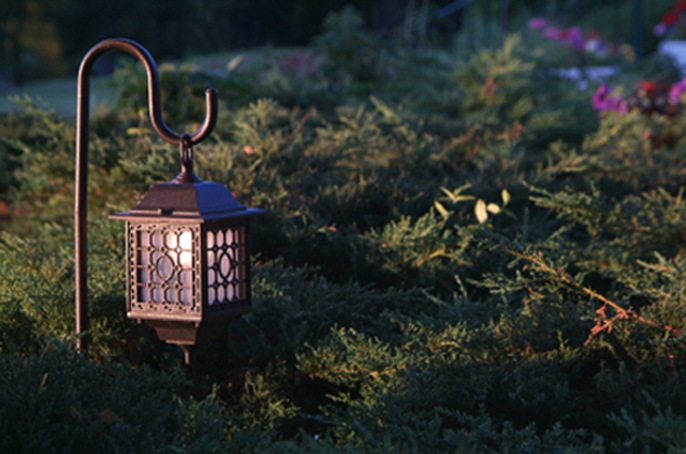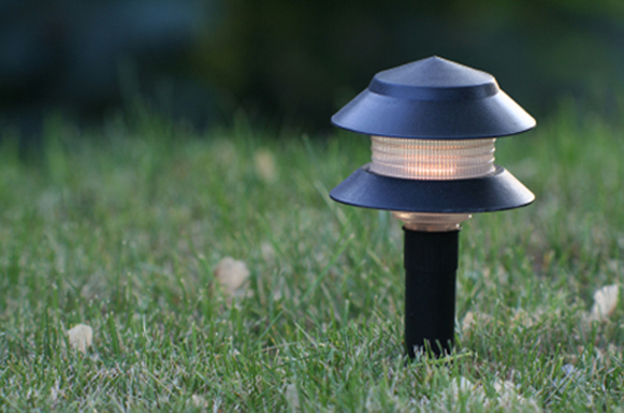Outdoor Lighting: Technology, Techniques, and Fixtures
Video
Outdoor lighting illuminates social gatherings, comforts us with additional safety and security, enables us to work or play, and enhances our home garden aesthetics from dusk to dawn. With the variety of outdoor lighting fixtures available, selecting the right one can be somewhat daunting. Understanding the available outdoor lighting technologies, techniques, and fixtures will allow you to make better use of your property after the sun goes down.
Outdoor Lighting Technology
A variety of technologies light the exterior of our homes. If you have spent any time shopping for outdoor lighting you have probably noticed that fixtures are manufactured for specific types of energy: electrical, solar, and gas.
Electrical Power
 Electrical power is a conventional energy source that serves standard and low-voltage light fixtures.
Electrical power is a conventional energy source that serves standard and low-voltage light fixtures.
- Standard 120V AC Power Systems are hard-wired to your home's electrical panel in accordance with local building codes. The wiring needs to be protected from the elements and requires that specific measures be taken during installation to ensure safety. Qualified Energy Star-labeled fixtures provide energy-efficient options that help to keep operating costs lower than traditional lighting. Additionally, accessories such as timers, photocells, and motion detectors automate outdoor lighting.
- Low-Voltage Lighting is also hard-wired; however, it uses a transformer that converts the 120V AC from your home's electrical panel to 12V AC. Low-voltage lighting is reliable, but if a system is not properly planned and correctly installed, it can experience voltage drop (i.e., a decrease in available power over the distance of the wiring). Low-voltage lighting produces less light then standard lighting; however, the lower voltage reduces safety concerns and uses less electricity, keeping down your operating costs.
Solar Power
Solar power is an alternative energy source that is harnessed by solar cells or photovoltaics (PVs). While the sun shines, PVs collect and convert energy from sunlight into electricity. This electrical energy is stored in an internal rechargeable battery. When the sun goes down, an internal photoresistor enables increased resistance within a fixture's circuit, allowing for the flow of electricity through the circuit. As electricity flows, the light turns on. Solar-powered lighting is only as reliable as the duration, availability, and intensity of sunlight in your area. Solar-powered lighting has no operating cost and is safe to install, requiring no wiring.
Gas Power
Gas power is a conventional energy source that delivers light by means of combustion. Gas-powered light fixtures have internal supply piping that delivers fossil fuel (natural gas or propane) and an automatic ignition that is controlled by an interior, electrical wall switch. When the switch is activated, the igniter sparks, igniting the fossil fuel and creating a flame. Gas lighting was commonly used before electrical lighting became readily available. Gas lighting provides an old-fashioned type of light that is relatively safe and reliable.
Outdoor Lighting Techniques
Lighting, whether indoor or outdoor, is typically classified as ambient, task, or accent lighting. Ambient, or what is commonly referred to as general, lighting illuminates a large area. Task lighting provides light that is concentrated in a small area for a specific purpose, and accent lighting directs your eye to an element of decoration, highlighting the element and imposing a more dramatic scene. Depending on what you want to achieve with your outdoor lighting, you might incorporate one or all of the above kinds of lighting by using various lighting techniques.
Lighting techniques are methods of applying light, from one fixture or multiple fixtures, to specific elements or areas, to achieve a desired effect. Three basic techniques are used in outdoor lighting: downlighting, uplighting, and transverse lighting. Downlighting uses a fixture installed above the element being lit. Uplighting and transverse lighting use fixtures installed at ground level. Uplighting is installed below an element, directing light up, and transverse lighting is installed in front of an element, directing light across the ground. Other techniques are essentially variations of these three basic techniques.
 Spread Lighting uses fixtures installed within landscaping or at fixed locations on walls, ceilings, or posts. Illumination increases visibility in gardens and flower beds and at entries.
Spread Lighting uses fixtures installed within landscaping or at fixed locations on walls, ceilings, or posts. Illumination increases visibility in gardens and flower beds and at entries.- Path Lighting uses multiple fixtures installed along sidewalks or pathways. Downward illumination increases visibility at night, allowing for safe travel along walkways.
- Spot Lighting uses fixtures installed in front of elements and accentuates architectural details or the texture of landscaping.
- Cross Lighting uses multiple fixtures installed in front of elements. Illuminating an element from two or more angles plays with light and shadow, creating a dramatic focal point.
- Silhouetting or Back Lighting uses a fixture installed behind a landscape or hardscape element. Illuminating upward accentuates the shape of that landscape or hardscape.
- Shadowing or Side Lighting uses a fixture installed to the side of an element. Illuminating from the side accentuates the structure of a landscape element and allows you to create and position shadows.
- Grazing or Washing uses a fixture installed near the base of a vertical surface. Illuminating upward enhances the texture of a building's facade.
- Moon Lighting uses a fixture installed in the branches of a tree and illuminating downward; this supplies dramatic light that filters through tree branches.
- Tree Lighting uses a fixture installed at the base of a tree. Illuminating upward accentuates the structure and/or highlights the foliage of a tree.
- Pool Lighting uses submersible fixtures installed in various locations within a pool. Illuminating a pool increases visibility, promoting safe swimming at night, and offers dramatic lighting effects, adding to the ambience of an evening.
- Deck Lighting uses fixtures installed in various locations on a deck. Illuminating areas along a deck provides ambient light that warms social gatherings or quiet evenings after the sun has gone down.
- Stair Lighting uses fixtures installed on the risers. Illuminating the steps increases visibility at night, allowing for safe travel up and down the stairs.
- Security or Flood Lighting uses fixtures installed at various locations around the home. Installing a motion detector near doors or windows where an intruder could gain entry to your home or flood lighting areas where an intruder could hide are excellent deterrents against theft and vandalism.
- Task Lighting uses fixtures installed at various locations around the home where a specific activity is performed. Illuminating downward from the top of a basketball hoop, for example, allows the court to be used after the sun has gone down. Another popular spot for task lighting is at the grill, adding hours of use.
Outdoor Lighting Fixtures
Outdoor lighting can be used in virtually any manner around the home. Fixtures are designed and manufactured for specific types of energy and various lighting techniques, and they come in a variety of sizes, styles, and finishes.
Outdoor lighting fixtures are either movable or non-movable. Movable outdoor light fixtures are typically solar-powered stake lights that can be easily taken up and repositioned, while non-movable outdoor light fixtures are hardwired and installed in a specific locations. Non-movable outdoor lighting is either fixed (i.e., the fixture emits a constant light) or adjustable and can be dimmed if desired. Common types of fixtures include wall, ceiling, post, pathway, flood, spot, step, bollard, and yard lights. Specialty types of fixtures include submersible, flag pole, basketball hoop, motion sensor, dusk to dawn, and dark sky friendly lights.

Jeff Calcamuggio
Jeff is an Editor-at-Large for Buildipedia.com who writes and edits Featured At Home and Knowledgebase content. Prior to joining Buildipedia, Jeff's work experience included carpentry, construction documentation, specification writing, construction administration, project management, and real estate property inspection. Jeff is a member of the Construction Specifications Institute (CSI) and an educator at Columbus State Community College and enjoys challenging DIY home improvement projects.
†

